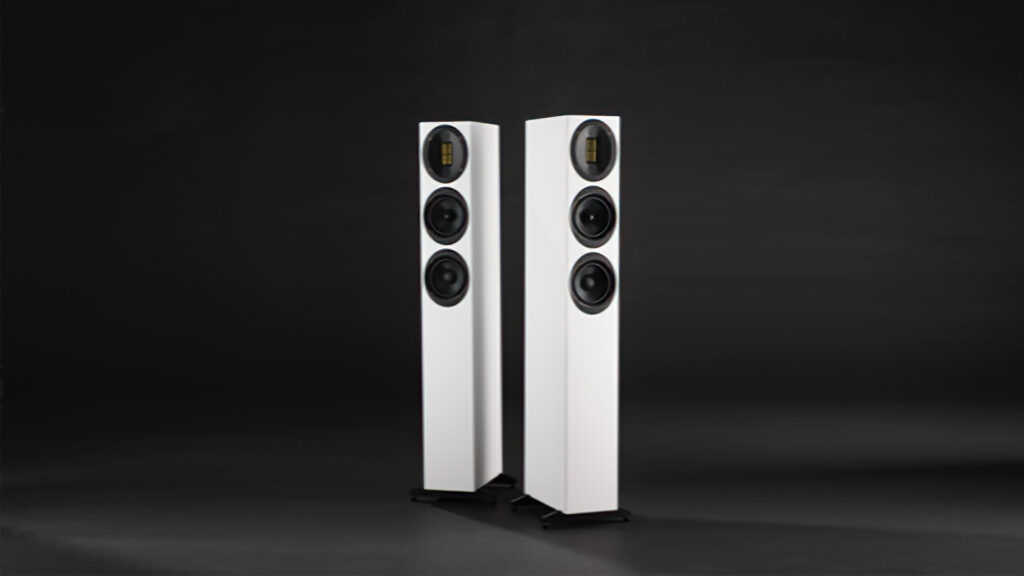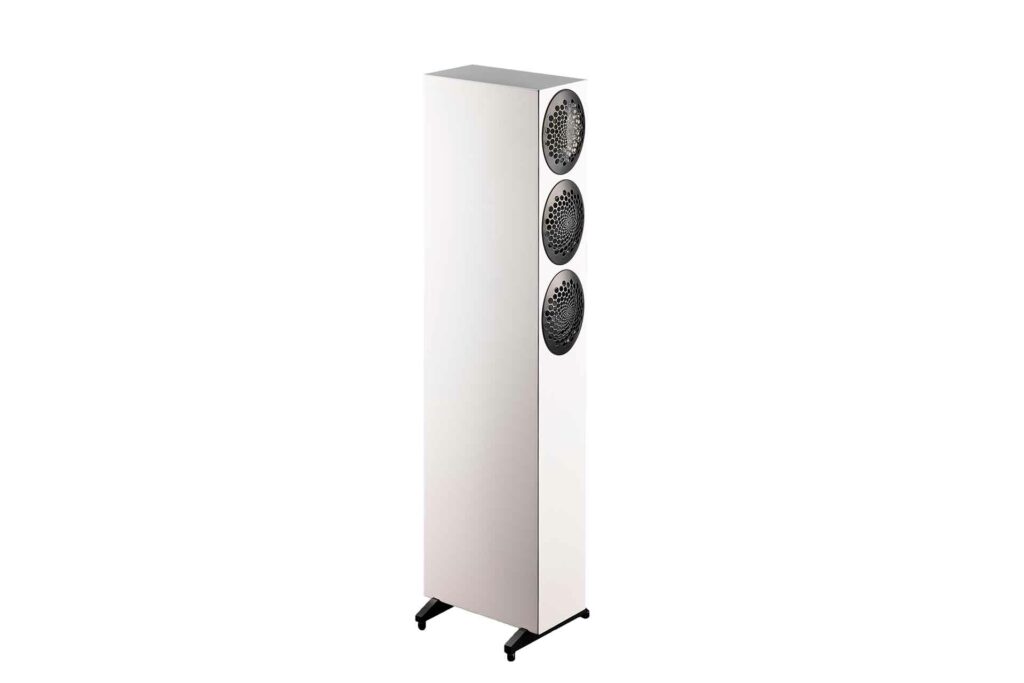Scansonic is relatively unknown speaker brand at this point in the United States, but is uniquely related to some more familiar speaker brands such as Raidho Acoustics and ScanSpeak. In fact, it was developed to showcase ScanSpeak driver technology. Scansonic is now owned by Dantax A/S, which also owns the critically acclaimed and quite pricey Raidho Acoustics. Scansonic utilizes less-exotic components and designs than Raidho, but there are some obvious similarities in design. Under review today is an offering from the company’s M Series, the middle of the Scansonic lineup, which features five different speakers. The M20 is the smaller of the two floorstanding speaker options and retails for a competitive $2,099 per pair.

What Makes the Scansonic HD M20 Special?
- The Scansonic’s form factor is really appealing in that the HD M20 is a compact 2.5-way, bass reflex floorstanding speaker that measures 5-1/8 inches wide by 9-7/8 inches deep and 35.5 inches tall (not including the outrigger feet, which add about an inch in height and four inches of width) and weigh in at just under 27 pounds each.
- The Scansonic HD M20 uses a sealed ribbon tweeter with a Kapton/aluminum composite membrane and two 4.5-inch drivers. The first is a mid-woofer with a phase-plug, the second is strictly a woofer, and both have cones made from honeycomb-enforced glass fiber. The tweeter-to-mid-woofer crossover is a second order crossover at 4 kHz, and the mid-woofer-to-woofer crossover is a first order crossover at 300 Hz. Frequency response is stated simply as 50 Hz to 40 kHz. Sensitivity is stated simply at 86.5 dB. I assume that is at one watt/meter. That’s pretty low in comparison to other speakers in the HD M20’s price range.
- The Scansonic HD M20 cabinet has a modern, narrow profile with non-radiused edges. Each driver is covered by its own rigid press-fit metal grilles, with large holes that remind me of the Paradigm Persona series. While the speakers are available with either Silk White or Silk Black cabinets, the grilles are black. The slot-shaped ports are on the rear, above the bi-wireable speaker terminals, keeping the overall appearance clean, modern, and understated.
- The Scansonic HD M20 driver sizes and materials are a little unusual, especially for a speaker in this price range. While there is very little information available about the drivers, they do not appear to be off-the-shelf units. From what little I have been able to learn, the tweeter appears to be unique to Scansonic and shares some design traits with the tweeters from the Scansonic’s MB line as well as Raidho Acoustics.
Why Should You Care About the Scansonic HD M20 Loudspeakers?
All speaker systems involve tradeoffs during the design process. The choice of driver complement indicates a design preference for precise and nimble playback over volume and low-frequency extension. That’s very fair, and for many that will be appealing.
The narrow speaker baffle can reduce diffraction, which may help with imaging. The narrow profile has another, more practical benefit in that it can provide more flexibility with placement, which is also critical to optimizing your speakers’ performance.

Some Things You Might Not Like About the Scansonic HD M20 Speakers
- The highs are clean and detailed, but sound a little bit bit rolled-of or soft. The tweeters in the Scansonic HD M20s are well below ear height, so most listening positions are well off their vertical axis. I tried tilting the speaker back and found that this helped, but the M20’s still sounded ever-so- slightly rolled off, which for many could be just what the doctor ordered. If you like your high frequencies hot, this is not the right speaker for you. At around $2,000, the good news is that you can find pretty much anything you want in terms of flavors in floorstanding speakers.
- I heard a slight fuzziness in upper midrange (or lower treble) especially at higher volumes. This is not pronounced, but the extremely articulate midrange detail fades a little bit as frequency and volume are increased.
- The compact and narrow cabinet coupled with limited drivers means the low frequency extension and volume output will be somewhat limited versus physically larger speakers with larger drivers. If you are looking for concert sound pressure levels or pants-flapping bass, these speakers cannot do that, at least not by themselves. Pair them with a nice subwoofer and you could have the best of both worlds.
Listening to the the Scansonic HD M20 Speakers…
Listening to Weezer’s “Island in the Sun” from their self-titled album (aka the “Green Album”) streaming from Qobuz, I found a solid, well-formed soundstage that started slightly behind the speakers. Relative positions of individual instruments were easy to identify, but the sense of space or precise positioning was elusive. Brian Bell’s guitar was detailed and full bodied, as were River Cuomo’s vocals. Drums and bass guitar were tight and detailed and did not seem lacking in weight unless I compared them to the much larger RBH Sound SVTR speakers I also have in the room.
Hans Zimmer’s “Pirates of the Caribbean” medley from the Live in Prague album features a symphony fronted by the amazing Tina Guo on electric cello (Eagle Rock via Tidal). This piece has many overlapping components and the Scansonic HD M20s did a good job remaining composed and controlled as this piece built in complexity and pace. The soundstage on this piece was noticeably larger than with “Island in the Sun” both in width and depth, but remained positioned behind the speakers. The highs remained clean at all volume levels, never losing their composure but not delivering the extension or airiness found on my reference speakers. As before, the midrange was great. All of the instruments were reproduced with a balance of detail and weight. The low-end was still lacking, with the bass dropping off at a rapid rate around 50 Hz, so I connected a SVS SB-3000 subwoofer and got it dialed in. I connected this without any bass management to the signal being sent to the M20s. Playing the same track again, I found the subwoofer made a positive difference by adding low frequency weight and extension without compromising the strengths of the M20.
Do the Scansonic HD M20s Have Good Resale Value?
They are a new player in the game, which put them at a disadvantage to others in the ultra-competitive $2,000 per pair floorstanding speaker market, but a well-designed speaker is likely to remain a capable component of your (or someone else’s) stereo playback system, so perhaps resale isn’t the best metric by which to determine value here. The small form factor means that the M20s will be flexible in placement for anyone who might own them. If you want to use them in a larger room, a subwoofer will help. If you want to use the Scansonic HD M20s in a smaller room, they will fit without over powering it either physically or sonically. All of these factors will help with resale, as will the all-star designer and the design pedigree of the other related brands like Borresen, Raidho, and ScanSpeak. That’s likely your best bet for strong, long-term value.
Who is the Competition for the Scansonic HD M20s Loudspeakers?
- Wharfdale’s Evo 4.4 ($2,198) has an AMT tweeter at the top of its four-driver, three-way configuration, which is in a slightly larger tower cabinet. The Wharfdales have a reputation for powerful bass and a refined tweeter and are more efficient than the M20s.
- ELAC Uni-Fi Reference UFR52 ($2,400 per pair – buy at Crutchfield) is another smaller three-way tower with a one-inch soft dome tweeter mounted concentrically within a four-inch aluminum cone midrange and three 5.25-inch aluminum cone woofers below. ELAC specifies the frequency range as 40 Hz to 35 kHz and sensitivity at 86 dB, which is similar to the M20s. This ported tower is also slightly larger than the M20.
- The Bowers & Wilkins 603 S2 Speakers ($2,300 per pair – buy at Crutchfield) is another three-way, four-driver system with a one-inch aluminum dome tweeter, six-inch Continuum midrange, and a pair of 6.5-inch woofers in a bottom-ported cabinet. It has been a while since I listened to these speakers, but I recall them having a bit more treble energy and reaching deeper in the bass regions but perhaps not with the same detail.
- The SVS Prime Tower ($1,200 per pair – buy at Crutchfield) is significantly less-expensive and about the same height, but has a slightly wider cabinet. It’s a three-way tower with a conventional driver array featuring a one-inch dome, 4.5-inch midrange, and dual 6.5-inch woofers that are rated to provide low end frequency extension down to 30 Hz.
Final Thoughts on the Scansonic HD M20s Loudspeakers
The Scansonic HD M20 speakers walk the fine line of balancing warmth and finesse across the critical midrange area where you find vocals, pianos, and so many more critical musical elements. I figured the small drivers combined with a narrow baffle may be great for allowing the speakers to sonically disappear, which they did, but I worried that midrange would sound thin. It didn’t at all. My hat is off to these lauded designers on achieving this sonic balance.
If you are looking for audiophile speakers that will reproduce enough detail for you to appreciate your best, most resolute recordings while maybe not calling too much attention to the harsh glare of vintage or early digital recordings, the Scansonic HD M20s may be the speaker for you. They provide enough flexibility to fit into many spaces that bigger speakers would not, while providing a nuanced and balanced presentation that makes for an engaging and enjoyable afternoon of listening to music. The Scansonic HD M20s loudspeakers are a new player in the game and come with one hell of a design legacy. It isn’t shocking at all that they sound so good for the money, and it is a plus that they work so well in tight installation situations.



